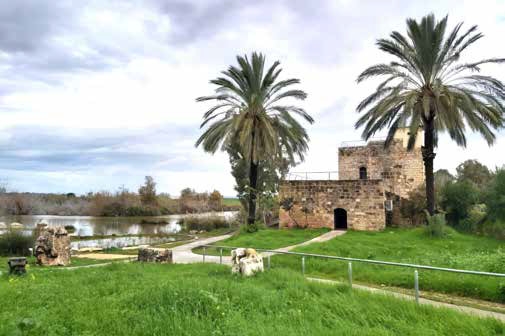En Afek Nature Reserve
Israeli wetlands where water buffalo roam
Text and Photos: Lydia Aisenberg
A short drive inland from Israel's northern coastal plain and the UNESCO Heritage Site of the ancient city of Akko (Acre), sits an extensive area of wetlands, boasting abundant water, fauna and flora in all shapes and sizes. This is one of the few places in Israel that have remained marshlands and where one can see a herd of water buffalo roaming in the gloaming – although at noon, more than likely sheltering somewhere in the shade and not so visible.
With a plethora of new high-rise neighborhoods marching like brigades of straight-backed concrete soldiers inland from Acre, the Israel Nature and Parks Authority's En Afek Nature Reserve encompasses the sources of the River Na'aman, which flows through the Zebulun Valley before spilling into the sea near Haifa.
Across one of the reserve's larger managed areas of water – known as The Great Lake – a wooden floating bridge, 250 meters long and just 1.20 meters wide has been constructed. Visitors are able to meander across while listening to the many sounds of nature, spot various species of fish in the murky waters, and admire the lilies and other vegetation, as well as wonder at the abundance of tamarisk and other trees and shrubs on the banks.
However, with no railings on the narrow floating bridge, one should not get too carried away. It is a somewhat daunting task to cross with young children in tow.
Apart from being unique in many aspects of nature preservation, En Afek also provides a welcome, necessary and educational super-soothing green lung to those residing in the rapidly developing urbanizations that encroach upon the nearby agricultural-based communities (kibbutzim and moshavim). The reserve also includes Tel Afek, an archaeological site also known as Tel Kurdani, containing the remains of the ancient town of Aphik, mentioned in Joshua 19:30 as belonging to the Tribe of Asher.
Many central and northern areas of the nowadays State of Israel were originally swamplands. Prior to Afek's draining in the mid to late 1930s, to create arable lands for the then newly-formed kibbutzim and reduce breeding grounds for the malaria-spreading mosquitos, water buffalo – brought to the area during the Ottoman period – also inhabited the area.
Buffalo were used as work animals by the local Bedouin, who in this region were renowned for their expertise at creating mats and baskets from the plentiful reeds and rushes found in the swamps.When the Afek wetlands nature reserve project got underway, a number of water buffalo were brought to Afek from the Hula Valley reserve. Nowadays a small herd can be observed from a specially-built elevated vantage point that overlooks another large expanse of water and their most favored watering hole.
Clearly marked pathways and specially-constructed bridges allow visitors to stroll through the incredibly rich abundance of vegetation, which comes in more hues of green and yellow than imaginable, and over the marshes, the large and small pools and the flowing streams. The routes can be easily followed with signage along the way and excellent in-depth informative maps, provided at the site entrance.
During the Crusader period, and with an abundance of different grains cultivated in the region, a large flour mill was built, as well as a dam and a small aqueduct directing water to the mill. The expansive flat-roofed two-floored thick stone building is complete with narrow slits for use if coming under attack. It has been renovated and with its attractive high-arched ceiling, is now used as a gallery and screening area.
The ascent to the roof entails climbing a very narrow, steep, musty, twisting stairwell. At the top of the stairwell is a small, stark concrete walled room – with attractive old-fashioned black and white diagonal shaped tiles on the floor – and a long, observation aperture, one meter in height, halfway up the north-facing wall. All of these were built by the British during the Mandate period and, according to a sign on the inner wall, the building was used as a guard post during the 1936-1939 Arab revolt against the British Mandate forces.
The panoramic view to the north from this rooftop vantage point is stupendous, taking in a large part of the Acre Valley and along the coast as far north as Nahariya and the Tyre mountain range – the present day border between Israel and Lebanon. To the east one can see the Lower Galilee ridge and looking south, Mount Carmel and the port city of Haifa









Comments